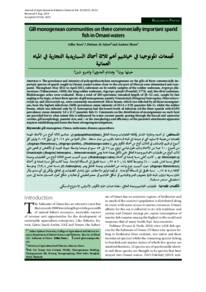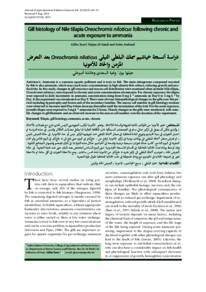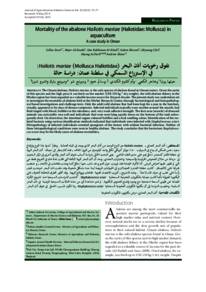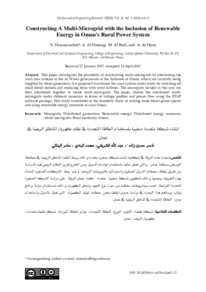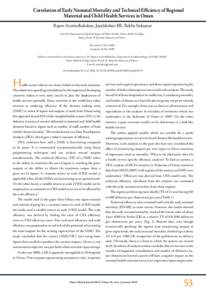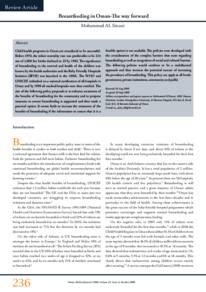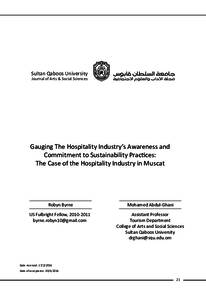Document
Gill monogenean communities on three commercially important sparid fish in Omani waters.
Contributors
Al-Adawi, Hisham., Author
Shinn, Andrew., Author
Publisher
جامعة السلطان قابوس. كلية العلوم الزراعية والبحرية
Gregorian
2015
Language
English
English abstract
The prevalence and intensity of polyopisthocotylean monogeneans on the gills of three commercially important species of sparid caught in Omani coastal waters close to the city port of Muscat were determined and compared. Throughout May 2012 to April 2013, infections on bi-weekly samples of the soldier seabream, Argyrops filamentosus (Valenciennes, 1830), the king soldier seabream, Argyrops spinifer (Forsskål, 1775), and, the silver seabream, Rhabdosargus sabra were evaluated. From a total of 200 specimens (standard length of 26–52 cm), caught by line angling or by traps, at least three species of gill monogenean, namely Omanicotyle [Bivagina] heterospina, Heteromicrocotyla sp. and Microcotyle sp., were commonly encountered. Silver bream, which was infected by all three monogeneans, bore the highest infections (100% prevalence; mean intensity of 20.14 ± 0.92 parasites fish-1), whilst the soldier bream, which was infected only by O. heterospina had the lowest levels of infection (of the three sparids with 63.8% prevalence; mean intensity 5.8 ± 0.17 parasites fish-1). Comments on the distribution of monogeneans on each host are provided but to what extent this is influenced by water current speeds passing through the buccal and opercular cavities, gill morphology, parasite size, and / or the morphology and efficiency of the parasite's attachment apparatus requires establishing and forms the basis of ongoing investigations.
Member of
ISSN
2410-1079
Resource URL
Citation
Yoon, G., Al-Adawi, H., & Shinn, A. (2015). Gill monogenean communities on three commercially important sparid fish in Omani waters. Agricultural and Marian Sciences Journal, 20 (1), 54-61.
Arabic abstract
تم تحديد ومقارنة انتشار وكثافة الطفيليات وحيدة العائل (polyopisthocotylean) في خياشيم ثلاثة أنواع من الأسماك المهمة اقتصاديا من فصيلة الاسباريد التي تم صيدها في المياه الساحلية بالقرب من ميناء مسقط. خلال الفترة من مايو 2012 إلى أبريل 2013 ولمرتين كل أسبوع تم تقييم الإصابات في الثلاث أنواع من أسماك الكوفر وهي: (Argyrops filamentosus , Argyrops spinifer , Rhabdosargus sabra). من مجموع 200 عينة من الأسماك (ذات طول قياسي تراوح ب 26 إلى 52 سم) تم صيدها بواسطة خيوط الصيد أو الأقفاص تم العثور على ثلاث أنواع من طفيليات الخياشيم وحيدة العائل على الأقل بصفة عامة وهي Omanicotyle (Bivagina) heterospina , Heteromicrocotyla, .,.sp Microcotyle sp كانت أعلى نسبة إصابة في أسماك (Rhabdosargus sabra) حيث أصيبت بجميع الثلاثة أنواع من الطفيليات وحيدة العائل بنسبة تفش بلغت 100% ومتوسط كثافة 20.14 ± 0.92 نسبة طفيل إلى السمكة الواحدة. بينما كانت أقل نسبة إصابة في أسماك (Argyrops filamentosus) حيث أصيبت بنوع واحد من الطفيليات وحيدة العائل وهو (O. heterospina) بنسبة تفش 63.8% ومتوسط كثافة 5.8 ± 0.17 نسبة طفيل الى السمكة الواحدة. تم أيضا توثيق ملاحظات حول انتشار الطفيليات في العائل، ولكن إلى أي مدى يتأثر ذلك بسرعة تيارات المياه المارة بتجويف الفم والخياشيم أو شكل الخياشيم أو حجم الطفيلي أو فعالية و شكل أجزاء التمسك بحاجة إلى بحث استقصائي مستمر مستقبلا.
Category
Journal articles

